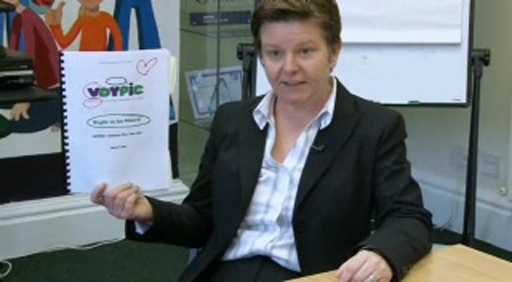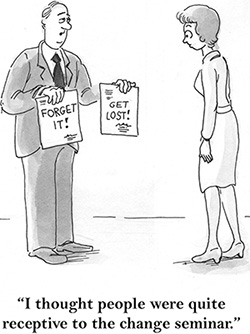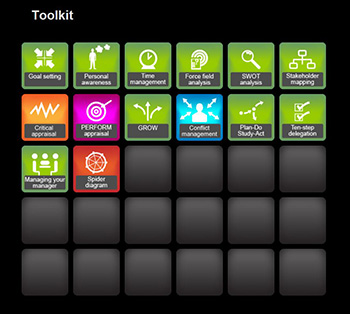Lead and manage change in health and social care
Use 'Print preview' to check the number of pages and printer settings.
Print functionality varies between browsers.
Printable page generated Friday, 19 April 2024, 4:57 PM
Lead and manage change in health and social care
Introduction
Change is everywhere in health and social care environments. It can evoke a range of emotions, from excitement and eager anticipation, to fear, anxiety or hostility. Alongside the ‘big ideas’ for change that are articulated at policy level, managers are engaged in a continual process of implementing small-scale changes that can make a real difference to people’s lives at a local level. While service users and frontline staff are also involved in change processes, it is often a particular responsibility of managers to make changes happen, and this can involve overcoming significant resistance.
In this free course, you will explore the role of managers in the change process, and the skills required for managing and leading change. You will also plan a change project.
This OpenLearn course is an adapted extract from the Open University course K313 Leadership and management in health and social care.
Learning outcomes
After studying this course, you should be able to:
appreciate the role of emotion and uncertainty in managing and leading change
demonstrate an awareness of how the approach to change can influence the way a manager might lead change
understand why change is considered so important in health and social care systems, yet is often so hard to successfully implement
outline a personal change management strategy and apply suitable tools to ensure successful implementation.
1 How do you handle change?
Change comes in a variety of guises, and the way we approach and handle it differs from person to person. In Activity 1, you will hear two managers talking about their experiences of managing change, before moving on to explore your own approaches to change.
Activity 1
Start by watching these videos of managers in health and social care contexts. Anita Rogers was chair of the Ceredigion and Mid Wales NHS Trust, and is now a member of the ‘Save Aber’ community action group, campaigning to save local hospital services. Vivian McConvey is the chief executive of VOYPIC (Voice of Young People in Care), a voluntary organisation in Northern Ireland.
Vivian and Anita talk about their very different experiences of change. As you watch the videos, make some notes on the key pressures for change they mention, and the ways in which they handled them. What words do they use to describe change, and what emotions do they express in response to their role as managers of change? Were you surprised by anything they said?

Transcript: Video 1

Transcript: Video 2
Discussion
Vivian and Anita each describe very different change processes. Anita reflects on her experiences of trying to manage a large-scale organisational change, which she eventually came to oppose, while Vivian discusses the changes she experienced when she moved into a senior management position.
The experiences they describe highlight that managing change is both a professional and personal process. Anita describes feeling ‘haunted’ by a feeling of powerlessness she experienced in her professional role, and notes how she now feels much more of a sense of power as a member of the Save Aber group. Vivian reflects on her initial lack of confidence when she began her role as Chief Executive, and notes how she eventually came to see this as a positive thing as it meant she took a more considered and thoughtful approach to her management style.
Anita and Vivian’s experiences illustrate the often extremely lengthy process that change involves. Both stress the importance of bringing other people on board to help them in the change process. The video shows Vivian discussing upcoming changes with her colleagues, and the roles her staff will take during the change process. Anita talks about the importance of networking with other individuals and groups who have the power to support the Save Aber campaign.
Activity 2
Now complete the checklist, ‘How do you handle change?’ using the range of options to record how strongly you agree or disagree with a statement. When you have finished, choose two statements that you strongly agree with and two that you strongly disagree with. Then, drawing on your own experiences, write down the reasons for your views.
Discussion
Anita and Vivian took very different approaches to managing change, but what their experiences highlight is the high level of emotion this involves. The change management checklist explored your own emotional reactions when faced with change. The statements you chose from the checklist will probably be closely linked to your own experiences. Reading through these statements, you may have been struck by how many related to the emotional impact of change and the importance of communication. Frustration, uncertainty and anxiety are just as likely to feature in people’s experience of change as feelings of excitement, optimism and commitment.
It is very easy for people to feel disempowered during a change process, and this is as relevant for people who use health and social care services as it is for practitioners. Of course, managers also experience heightened emotions during periods of change, but they are not necessarily permitted – by their own managers or by social conventions – to express these as freely as other colleagues. Managers need to take responsibility for their own feelings as well as supporting staff and services users through a change process, and that is why it is helpful as a manager to have an insight into your own approach to handling change.
In this section you explored personal approaches to change, and the emotions this can evoke. The next activity will help you to understand the pressures for change in health and social care contexts and will introduce some key ideas about change from organisational theory.
2 Understanding change

The image shows a cartoon of a man and a woman. The man is holding a piece of paper in each hand, on one is written ‘Forget it!’ and on the other ‘Get lost!’. Below the picture is the caption ‘I thought people were quite receptive to the change seminar’.
The next activity focuses on reading a chapter on managing change, as well as introducing some practical tools to help manage the change process.
Activity 3
Read the chapter Managing change in health and social care (Tilley and Jones, 2013). Take notes of the key points and anything you think is particularly important.
Ensure that you make a note of the three tools which you encounter in the chapter – force field analysis, stakeholder mapping and SWOT analysis – and what they are used for. You will need these notes for Activity 4.
Drawing on what you have learnt about your own attitude to change, together with specific tools designed to help a manager plan change, in the following activity you will be planning your own change management project.
3 Planning your own change management project

In the next activity you will be undertaking a piece of self-directed study, or enquiry-based learning. While we have set a task and recommended some tools, exactly how you carry it out is up to you and you are likely to come up with something very specific to your own situation. Working on your own in this way is something that, as a manager, you have to be able to do confidently on a daily basis, and so it is a key skill you should develop to improve your management and leadership ability.
Activity 4
This activity involves planning a change that you would like to make: preferably a task you have to do for your work anyway. If you are not working, choose a change that involves family members or social activities. Try to think of something that involves or affects several people. Start by thinking of a problem or a need for improvement and then think of how making a change could lead to better outcomes. Once you have identified an idea for change, draw on your notes from the previous activity, along with the change management tools you were introduced to (force field analysis, stakeholder mapping and SWOT analysis) to help plan your change.
Use the interactive toolkit below to access and complete your force field analysis, stakeholder mapping and SWOT analysis. The toolkit contains various other useful tools that you can explore.
Think about the following key questions:
- What is the issue as you see it – that is, what do you want to change and why? What is the problem or need for improvement at the moment? What benefit do you envisage following the change?
- What is your goal? What will ‘success’ look like afterwards?
- Who will be most affected and how and when will you consult with them and/or involve them?
- What additional evidence might you need to help you implement your change? How would you go about finding that?
Discussion
When a need for change is first identified, it may seem like a daunting prospect. However, as you have hopefully experienced working through this activity, any change can be approached in a logical and considered manner. Breaking the task down into clear steps and goals, gathering necessary evidence and applying useful management tools where relevant can all help to smooth the journey through that change process. In this activity you have planned how you might work through such a process in your own personal or work life, but the same approach applies to any change in health and social care, whether it is implementing a new entertainment programme in a residential care home or planning the merger of two hospital trusts.
Conclusion
Learning how to develop your own change project is a key skill for all managers. It is highly likely that whatever context you work in, you will – at some point – be tasked with implementing a change process. Alternatively, you may find yourself passionate about a particular idea and decide to build a base of support to launch your own change initiative. Either way, drawing on existing literature, research evidence and change management tools in a reflective and critical way will support your future endeavours in managing change.
You will remember from the video at the beginning of the course that Vivian compared the way her management style has changed to different styles of cooking. She talked about starting off like Delia Smith, following a recipe really strictly, but said that nowadays she is more like Jamie Oliver, adding ‘a glug of this and a dash of that’. This free course has allowed you to explore different ingredients for managing change – now you can decide whether you are more of a Delia or a Jamie in your approach to change management!
The following references are a useful guide to further reading, and you can access them through a library or suitable online resource.
- The change management literature is vast, and you may want to do further reading to follow up on some of the key concepts. These references are a good place to start:
- Cameron, E. and Green, M. (2009) Making Sense of Change Management: A complete guide to the models, tools and techniques of organizational change, 2nd edn, London, Kogan Page.
- Dawson, P. (1994) Organisational Change – A processual approach, London, Paul Chapman Publishing.
- Staff resistance to change has been recognised for many years to be a huge issue for managers. The following references suggest some ways to understand and overcome this. Although they were written some years ago, they have become ‘classics’ and are well worth reading as so much later work builds on their ideas.
- Kotter, J.P., and Schlesinger, L.A. (1979) ‘Choosing strategies for change’, Harvard Business Review, vol. 57, no. 2, pp. 106–14.
- Lewin’s force field analysis is a seminal tool for exploring change. If you enter the term ‘Lewin’s force field analysis’ into a search engine, you will find links that will tell you more about it – but remember to assess the reliability and source of the web pages you find.
- In the ‘Managing change in health and social care’ reading in Activity 2 you were introduced to Joan Simons’s change project on a children’s hospital ward. If you are interested in exploring Joan’s experiences and research further, there are also two published journal articles available to read:
- Simons, J.M. and MacDonald, L.M. (2006) ‘Changing practice: implementing validated paediatric pain assessment tools’, Journal of Child Health Care, vol. 10, no.2, pp. 160–76
- Simons, J.M. and MacDonald, L.M. (2004) ‘Pain assessment tools: children’s nurses’ views’, Journal of Child Health Care, vol. 8, no. 4, pp. 264–78.
- You could explore some websites specifically designed to provide access to practical management tools, guidance and research literature in health and social care, which contain information about managing change:
- Social Care Institute for Excellence
- Social Care Online for links to extensive resources
References
Acknowledgements
This free course was written by Liz Tilley and Rebecca L. Jones.
Except for third party materials and otherwise stated (see terms and conditions), this content is made available under a Creative Commons Attribution-NonCommercial-ShareAlike 4.0 Licence.
The material acknowledged below is Proprietary and used under licence (not subject to Creative Commons Licence). Grateful acknowledgement is made to the following sources for permission to reproduce material in this free course:
Every effort has been made to contact copyright owners. If any have been inadvertently overlooked, the publishers will be pleased to make the necessary arrangements at the first opportunity.
Course image
Copyright © Kristina Stasiuliene/Shutterstock.
Text
Activity 1: Reading: Tilley, L. and Jones, R.L. (2013) ‘Managing change in health and social care’, Chapter 4 in McKian, S. and Simons, J. (eds) Leading, managing, caring: understanding leadership and management in health and social care, London, Routledge.
Images
Contained in Reading: Figure 4.1: BradCalkins/iStockphoto.com; Figure 4.2: Rusty’s Photography; Figure 4.3: annedde/istockphoto.com; Figure 4.4: © Emotional Intelligence 4 Change, www.ei4change.com.
Figure 1: (cartoon): © Andrew Toos/www.CartoonStock.com.
Figure 2: (London 2012 Olympics security): © Demotix/Press Association Images
Videos
Copyright © The Open University
Don't miss out
If reading this text has inspired you to learn more, you may be interested in joining the millions of people who discover our free learning resources and qualifications by visiting The Open University – www.open.edu/ openlearn/ free-courses.
Copyright © 2016 The Open University
